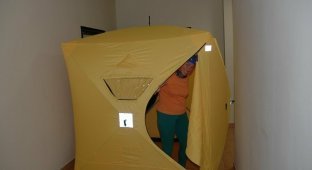How people in different countries heat their homes and why it’s hard for us to understand them (10 photos)
Everything is interesting abroad too. 
Heating your home is a vital thing. Especially here and during the long winter. And not everyone is happy with their heating bills, and it is customary to criticize the work of the housing and communal services. To be fair, sometimes there is a reason for it.
Although everything is known in comparison. So let's see how things are with heating in other countries. Maybe then our "bad" will turn into very good? Or vice versa.
Finland 
The people of this country love saunas and warmth. There are two heating options to choose from: gas and electricity. And it is cheaper to use the latter.
In Finnish homes, they most often have individual heating systems. They are rarely turned on at full blast, but are adjusted so that the room has an acceptable temperature. No one in Finland does this by heating “with a reserve” - like we do here - they count kilowatts very carefully there. Now the Finns are discussing the possibility of using the heat from crematoriums, it just goes into the air anyway, and this way it will work for society. But they haven’t decided on this yet.
France 
The country has a mild, pleasant climate, and in winter the temperature rarely drops below +6°C. So the French don’t bother with heating and use “spot heating”: they install an electric heater in the apartment and turn it on when needed. They don’t need central boilers and other complications.
Canada 
Inverter split systems are most often used for heating. In our country they are idle from September to June, but in Canada they are used for heating.
South Korea 
They don’t like vertical heating here and almost never use it: Koreans don’t see the point in heating walls. But they do use “ondol” – a technology for warm floors. For them, it's not even a detail of the interior, but a philosophy and a way of life: Koreans sit on the floor, eat, sleep and receive guests. With warmth and comfort.
Iceland 
This is a volcanic island with constant geothermal activity. Hot geysers beat straight from the ground and smart Icelanders have learned to pump water from them directly into the heating system. Therefore, the springs work like giant thermoses: they heat houses, pools and greenhouses. Just a minute, they even got used to growing bananas in them. Heating is cheap and very effective - no one there is definitely chattering their teeth from the frost.
China 
Central heating is common in the northern provinces - the climate there is especially harsh. Residents of other territories use electric blankets, heated rugs and other ingenious devices. And in the villages they still heat the stoves, because China is a country of contrasts. There are huge and technically very developed megalopolises, and there are provincial villages as if from the 15th century - there are no heated blankets there and never were.
England 
The British are quite ascetic in matters of heating and count every penny spent on hot water and heat. They turn on the radiators, but only when they are at home. Some even walk around the house in a sweater so that it is not too cold. Sometimes they wash in lukewarm water - also for reasons of economy.
Germany 
So their “green energy” smells of gentle wood smoke. This is only partly true. In villages, they really do heat their houses with stoves and throw sawdust pellets in there. Cheap and cheerful. On the other hand, there are large and developed cities that have centralized heating and no one there suffers much from the cold. 
To sum it up: in Europe and Canada, gas is used mainly in industry. Houses are heated with electricity. People live in insulated and energy-efficient houses and save resources - this is a necessity. In Asia, it is about the same, but with its own characteristics. In our gas power, in theory, there should be no problems with heat at all. But the country is still gasified by ⅔ - there is still room for improvement. Plus, it is worth carefully monitoring the tariffs for this fuel - recently, the price for it has begun to increase for domestic consumers. If these issues are resolved, there will never be problems with heat in our country.
Well, let the Europeans sort out their own heating.


























